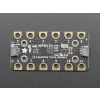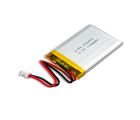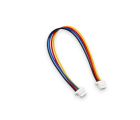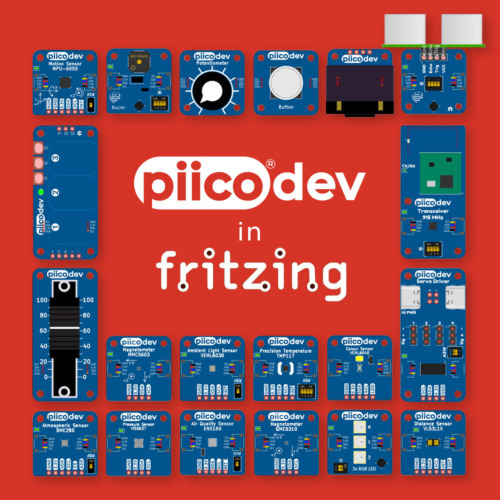Adafruit MPR121 12-Key Capacitive Touch Sensor Gator Breakout - STEMMA QT / Qwiic
In stock, ships same business day if ordered before 2PM
Delivered by Tue, 16th of Dec
Quantity Discounts:
- 10+ $11.37 (exc GST)
- 50+ $11.15 (exc GST)
Add lots of touch sensors to your next microcontroller project with this easy-to-use 12-channel capacitive touch sensor breakout board, starring the MPR121. This chip can handle up to 12 individual touchpads with plug-and-play STEMMA QT connector and large alligator/croc-clip friendly pads, its a no-solder solution to capacitive touch sensing.
The MPR121 has support for reading data over I2C, which can be implemented with nearly any microcontroller. You can select one of 2 addresses with the ADDR pin (solder it close for the alternative address), for a total of 24 capacitive touch pads on one I2C 2-wire bus. Using this chip is a lot easier than doing the capacitive sensing with analog inputs: it handles all the filtering for you and can be configured for more/less sensitivity.
This sensor comes as a tiny hard-to-solder chip so they put it onto a breakout board for you. Since it's a 3V-only chip, Adafruit added a 3V regulator and I2C level shifting so it's safe to use with any 3V or 5V microcontroller/processor like Arduino. Adafruit even added an LED onto the IRQ line so it will blink when touches are detected, making debugging by sight a bit easier on you.
Comes with a fully assembled board. For contacts, we suggest using copper foil, metallic nylon, or pyralux, then connect up any alligator clip from the conductive material to one of the big pads on the breakout.
To make using it as easy as possible, we’ve put the MPR121 on a breakout PCB in our Stemma QT form factor with a sprinkle of support circuitry to give you options when testing. You can either use a breadboard or the SparkFun qwiic compatible STEMMA QT connectors, and compatibility with 5V voltage levels as commonly found on Arduinos, as well as 3.3V logic used by many other boards like the Raspberry Pi or Adafruit's Feathers. QT Cable is not included, but Adafruit have a variety in the shop for quick plug-and-play support.
Getting started is a breeze with Adafruit's Arduino and CircuitPython/Python libraries and tutorials. You'll be up and running in a few minutes, and if you are using another microcontroller, it's easy to port Adafruit's code.
Of course, Adafruit wouldn't leave you with a datasheet and a "good luck!" - Adafruit wrote a detailed tutorial showing how to wire up the sensor, use it with an Arduino, and example code that gets the sensor logging data and detecting your touch!
Technical Details
- Product Dimensions: 51.0mm x 25.2mm x 4.5mm / 2.0" x 1.0" x 0.2"
Exact shipping can be calculated on the view cart page (no login required).
Products that weigh more than 0.5 KG may cost more than what's shown (for example, test equipment, machines, >500mL liquids, etc).
We deliver Australia-wide with these options (depends on the final destination - you can get a quote on the view cart page):
- $3+ for Stamped Mail (typically 10+ business days, not tracked, only available on selected small items)
- $7+ for Standard Post (typically 6+ business days, tracked)
- $11+ for Express Post (typically 2+ business days, tracked)
- Pickup - Free! Only available to customers who live in the Newcastle region (must order online and only pickup after we email to notify you the order is ready). Orders placed after 2PM may not be ready until the following business day.
Non-metro addresses in WA, NT, SA & TAS can take 2+ days in addition to the above information.
Some batteries (such as LiPo) can't be shipped by Air. During checkout, Express Post and International Methods will not be an option if you have that type of battery in your shopping cart.
International Orders - the following rates are for New Zealand and will vary for other countries:
- $12+ for Pack and Track (3+ days, tracked)
- $16+ for Express International (2-5 days, tracked)
If you order lots of gear, the postage amount will increase based on the weight of your order.
Our physical address (here's a PDF which includes other key business details):
40 Aruma Place
Cardiff
NSW, 2285
Australia
Take a look at our customer service page if you have other questions such as "do we do purchase orders" (yes!) or "are prices GST inclusive" (yes they are!). We're here to help - get in touch with us to talk shop.
Have a product question? We're here to help!
Guides
The Maker Revolution
Projects
PiicoDev Ecosystem In Fritzing
10" Home Lab Testing Rack
WLED Hourglass Theatre Prop - DMX Over Wi-Fi!
Makers love reviews as much as you do, please follow this link to review the products you have purchased.


















Product Comments